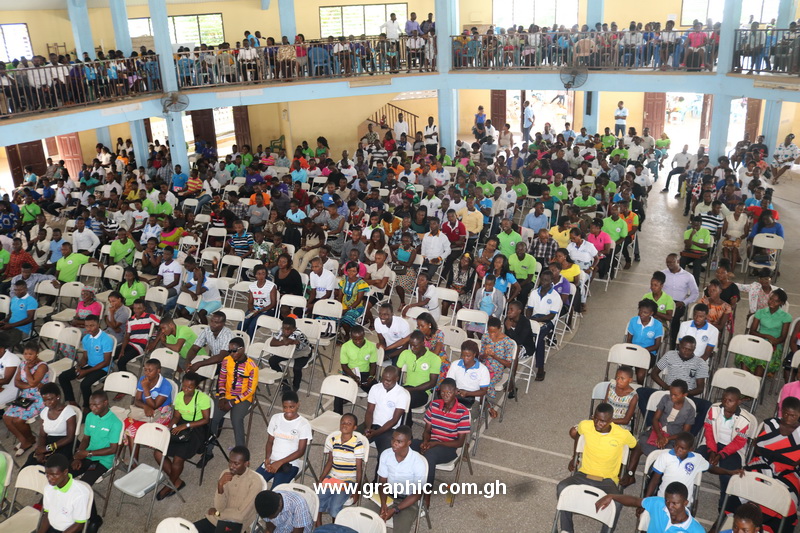
Skilled youths for improved employment
A third of Ghana’s population is between the ages of 15 and 34, but the country struggles to offer employment for its youth.
Job creation has not kept up the pace with the country’s strong GDP growth, and among young people, unemployment has increased from 10 per cent in 2008 to 14 per cent in 2018, far exceeding the rate for adults.
Advertisement
Ghana also has lower levels of labour productivity than other African countries with a similar economic standing, partly because of inadequate training and industries experience a lack of employable workers with the relevant skills for their tasks.
Productivity and job creation are critical issues that require urgent attention and the government has initiated policies over the last decade to help the country take advantage of its youthful population.
However, public resources are always limited and Ghana is faced with many other competing policy options. Decision makers need to identify the interventions that can yield the greatest return for every cedi spent.
Ghana Priorities
Ghana Priorities, a collaboration between the National Development Planning Commission (NDPC) and the award-winning think tank Copenhagen Consensus, seeks to address this problem.
The project aims to find the smartest solutions for the country in a variety of critical areas ranging from health care to housing and education, using the proven method of cost-benefit analysis.
Since last year, 28 teams of economists have studied over 80 interventions to find the ones that generate the most good for every cedi spent not only in economic, but also environmental and social terms.
To improve employment generation for Ghana’s youth, Dr Charles Ackah and Dr Kwadwo Opoku from the University of Ghana and Dr Brad Wong of Copenhagen Consensus studied three interventions used widely around the world to improve skill development and bridge the gap between labour market needs and young job-seekers: vocational training, apprenticeships and start-up incubators.
Vocational education
Vocational education refers to the study of technologies and sciences and the acquisition of practical skills and knowledge necessary for various occupations.
Three years of technical education cost around GH¢34,000 per person, divided between direct costs for the government and the time and income forgone for the student.
The researchers project vocational training can lead to a significant productivity increase, reflected in a wage increase of 47 per cent, or GH¢44,000 over the person’s lifetime. Every cedi spent would generate GH¢1.30 pesewas of social good when compared to a scenario where the student goes into the workforce after basic education, instead.
If vocational education is compared to a student who instead goes on to senior high school (SHS) the benefit is even higher, at 2.4 times the original investment. This is because the extra years spent in school do not lead to much of a boost in the student’s future wages, making the vocational education path relatively more attractive.
To increase the number of students enrolling in vocational education, the government should build more technical institutes, create awareness and help ensure job opportunities in private-public partnership companies to absorb graduates.
Clothing and other important items needed for learning may also serve as barriers for poor households to enrol their children in secondary schools, so removing these costs for students of vocational and technical training institutes may also improve levels of enrolment.
Apprenticeship
Apprenticeship is the main institution through which people with junior high school (JHS) or lower levels of education are provided with training in Ghana.
This practice has traditionally been informal but highly extended in many sectors, from trades and crafts to agriculture and business.
Apprenticeships are beneficial to firms’ revenues and profits and more flexible than traditional vocational training. Students also gain more relevant skills, because they do hands-on work and learn by observation.
The researchers estimate the cost of formal apprenticeship training at GH¢6,000 per person and a lifetime wage increase for each participant is 65 per cent compared to those with no apprenticeship training.
The total benefits were estimated at nearly GH¢15,000, including additional benefits to the firm from hiring the apprentice. Every cedi spent on apprenticeship would thus generate a return worth GH¢2.40 pesewas.
Start-up
The possibility of helping small and medium enterprises through start-up incubators was also studied, but a lack of reliable data impedes the development of a cost-benefit analysis.
However, small and medium companies are a source of massive employment creation in economies around the world and boosting their growth can be useful for helping private sector development.
Measures to increase skill levels among Ghana’s youth can help improve both employment rates and economic growth.
Skilled workers may also boost the productivity of the economy and improve wages, so the overall impact of the interventions could be even higher than projected in this study.
Among the educational interventions studied in the Ghana Priorities project, quality primary education has a higher impact on increasing productivity in the long term than initiatives focusing on SHS school or job training.
Still, the challenge of unemployed and unskilled youth is urgent and pressing and beneficiaries of early childhood interventions will only hit the workforce in 10-15 years.
Vocational training and apprenticeship can help improve this situation.
The writer is the President of the Copenhagen Consensus and Visiting Professor at Copenhagen Business School.



